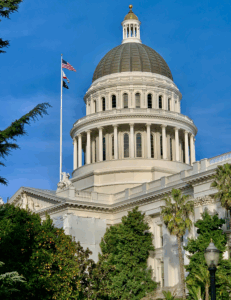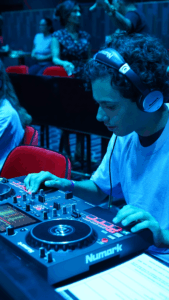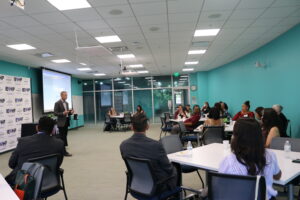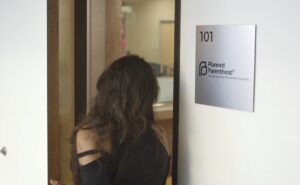After attack, city doing its best to cope a year later
8 min read
Photo/Anthony Victoria: The San Bernardino Memorial for the Dec. 2 terrorist attack victims, August 2016.
‘San Bernardino Strong’ is the motto that carried the struggling city forward in the wake of a terrorist attack that killed fourteen people at the Inland Regional Center on the morning of December 2, 2015.
It also serves as the adage for a community attempting to rise out of bankruptcy and end the surge of homicides.
“This city is not going to be defined by a singular moment,” said Mayor Carey Davis in an interview last week with IECN. “In spite of our struggles, we managed to show support for survivors [of the attack] and for our community.”
A year after one of the most deadliest mass shootings in recent U.S. history, some residents believe the city has a long way to go until it sees prosperity and stability return.
“We’ve minimized people’s lives to numbers,” CHORDS Chief Executive Officer Edwin Johnson said in regards to the increase of homicides in the last year. “It has to go beyond that. We have to look at what we all can do to help our community.”
For others, the business of daily life didn’t change much amid the aftermath of the attacks.
“Following the attack we held each other,” expressed resident Michelle Sabino. “We cried with strangers, and we were softened…for a moment. It wasn’t long before we reverted back to business as usual, callused by murders…I think we are all doing our best to just survive.”
Mayor Davis reflects on first 48 hours after attack
Davis was at the Santa Fe Depot in Downtown San Bernardino when he heard news of the shooting.
“I was at a [San Bernardino Associated Governments] meeting on that day,” recalled the mayor. “Not too long after the start of that meeting, someone tapped me on the shoulder and informed me of what was going on.”
Davis said he immediately left the depot–rushing back to City Hall, where he and his staff tried to sort out the details. With the assistance of San Bernardino Police Department Citizen Patrol officer and freelance photographer Ricardo Tomboc, Davis was able to listen to police dispatches from a scanner.
The next 48 hours would be hectic for Davis and his staff. After helping reconnect survivors with their families at the Rudy Hernandez Community Center, undergoing a debriefing by Police Chief Jarrod Burguan on the FBI’s investigation of the attack, organizing an emergency City Council meeting to maintain peace among residents, holding press conferences and interviews with cable news networks, and helping organize a prayer vigil, the 63-year-old city leader had only slept for about 6 hours.
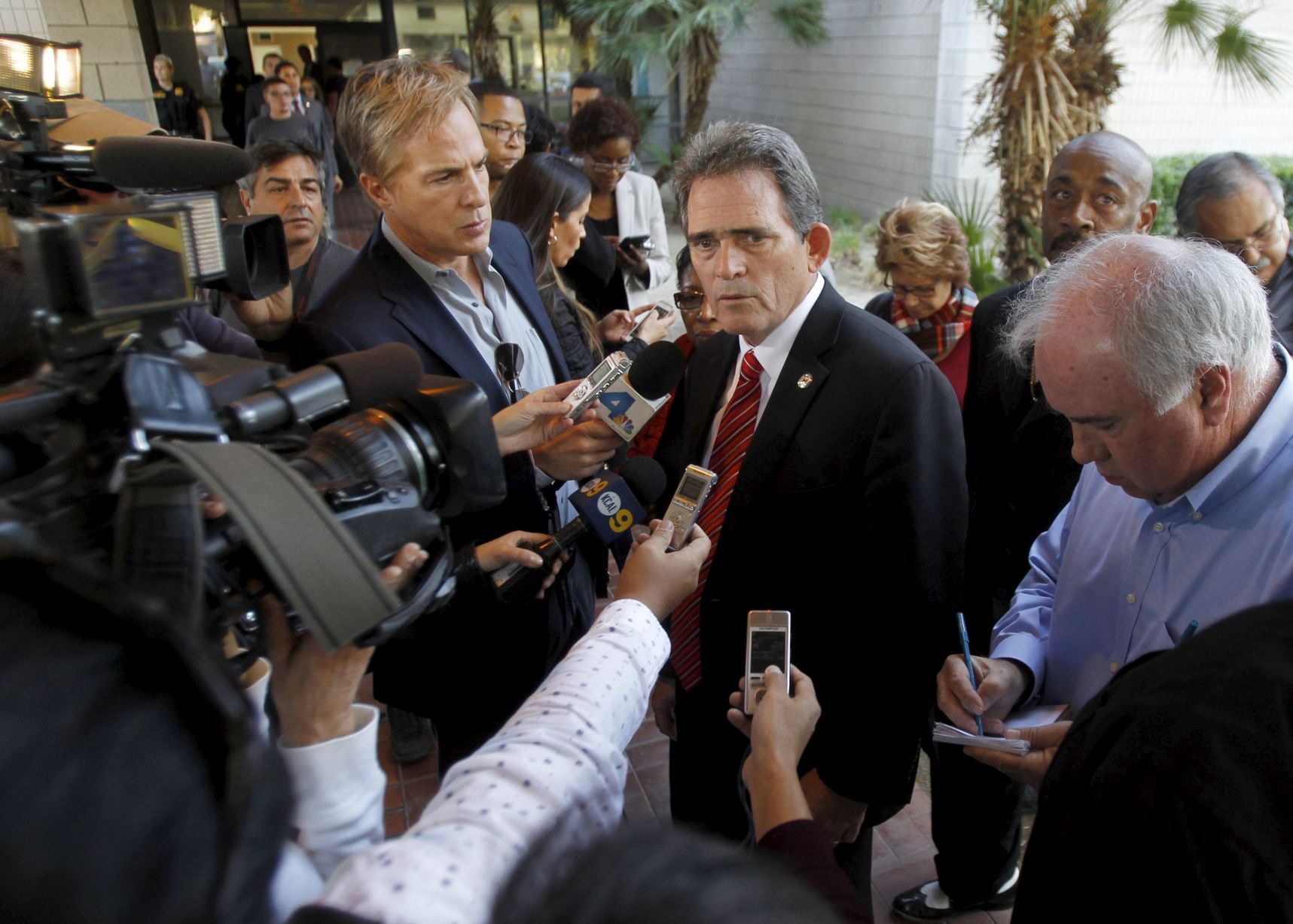
In addition, providing support to survivors and the families of victims was a difficult task that Davis admits created a “somber” atmosphere.
“We realized we didn’t have the luxury of sleep,” Davis explained. “Our initial goal was to bring normalcy and keep the city calm. We were trying to reach out and provide moral support for those who had to deal with this tragedy first hand.”
Davis indicated that there were two messages he diligently conveyed during the ordeal–refraining from politicizing the tragedy and abstaining from blaming the Muslim community.
“[CNN] asked questions on the gun control issue and we made it clear we didn’t want to discuss it,” Davis said. “They were OK with that. One of the messages I tried to communicate is not blaming it on religion. [The shooters] were acting on their own personal agenda.”
When asked if he had grown stronger as a leader as a result of dealing with the attack, Davis refrained from taking credit–instead acknowledging the team effort of councilmembers, city staff, and the San Bernardino Police Department.
“I don’t think it changed me,” he said. We identified priorities and found what was necessary at the moment. There was a sense of encouragement that resulted from it. Our law enforcement, specifically, was lauded by the nation for their response.”
Student describes struggles in aftermath of attack
San Bernardino Valley College Political Science student Sadia Khan was helping a fellow classmate with an assignment when she saw news feeds reporting an active shooter situation three miles away from campus.
“We kind of freaked out,” she said recollecting the moment. “We know there are a lot of shootings that happen here, but we didn’t realize the enormity of it at first.”
Khan said she and other students, with the help of faculty, were consoling people and trying to maintain peace. Incoming news reports–detailing the grim details of the attack–only caused more panic, the 21-year-old single mother explained.
“It just got worse and worse,” she said.
Khan paused for a moment and began to speak again–this time her voice cracking and tears streaming down her cheeks.
“I was praying that the shooters weren’t Muslim,” she said. “After September 11, we Muslims received a lot of abuse from the community.”
As students at San Gorgonio High School, Khan and her siblings, Muhammad, Maria, and Hamza, faced racial harassment from classmates. She remembers students opening her backpack, and saying things like, “I’m checking for a bomb inside.”

“That kind of stuff messes you up,” Khan expressed.
Two days after the attack, Khan’s brother Muhammad, a student at Cal State San Bernardino, alleged he experienced harassment and discrimination at a local Wal-Mart. Photos of him being approached by San Bernardino Police Officers surfaced on Facebook, causing backlash from residents who accused him of agitating store management and police officers.
”I didn’t expect backlash to come out so fast,” Sadia Khan said. “So many people were expressing hate against muslims on Facebook. In person we received cold shoulders and facial expressions. It instilled fear.”
Khan and her family began to attend events held by the Sahaba Initiative–a muslim nonprofit that provides assistance to residents in San Bernardino and Riverside Counties. It was through their services that Khan found comfort.
“I’ve never felt more accepted in my community,” Khan said. “People have gone out of their way to help me and my family. It’s important that we, as Muslims, show the community that we’re no different. We want to uplift our communities like everyone else.”
‘It was surreal’
Rialto resident Neri Perez was on the road driving when he heard radio reports of the incident at the Inland Regional Center.
He thought of his mom–a homecare provider–who was scheduled to attend a training session at the center that day.
“I thought to myself, ‘My mom could have been a victim’,” Perez said. “I received a call from her a while later. It was surreal.”
Victoria Bianchi and her husband Scott had only been living in San Bernardino for eleven months the day the attack happened. She recalls being in her bedroom, watching the news as events unfolded.
“It was like watching a movie,” Bianchi recalled. “I couldn’t really process how close it was to me.”
A few days later, Bianchi explained she had fear of walking outside because she was fearful of further attacks taking place. “I tried to go to the post office…I was worried that it would be a targeted area. I didn’t even realize how afraid I was.”
Wanting to become involved in city affairs compelled Bianchi to become involved in community service. She recently was approved to become a citizen patrol officer with the police department.
“The shooting was like a kick to the face–a blow to us when we were already down,” Bianchi explained. “I felt I had no choice but to get involved. I find it difficult to sit still when work needs to be done.”
Perez said the attack and the surge of violence in San Bernardino is proof that more law enforcement is needed.
“We lost a lot of people and it has been difficult recovering from that as a region,” said Perez. “The community is fighting for more security.”
Mentor helps youth cope
Every week Edwin Johnson visits San Bernardino High School and Indian Springs High School to teach hip-hop to students interested in writing, producing, and performing music.
“It keeps them off the street–away from the dangers of crime and violence,” he said. “Instead of shooting each other, they can come here and tap into their talents.”
Johnson, a 33-year-old resident of Rancho Cucamonga, considers the December 2 tragedy as an “amplified” version of what occurs on the streets of San Bernardino on a daily basis.
“I couldn’t believe it, man,” Johnson expressed. “My heart goes out to everyone who lost a loved one on that day. Unfortunately, this is what we see day-to-day.”
The city’s murder rate has been compared to that of much larger cities like Chicago–a connection that frustrates Johnson. He’s convinced leaders need to be more sympathetic towards residents who have lost loved ones to gun violence and need to be held accountable.
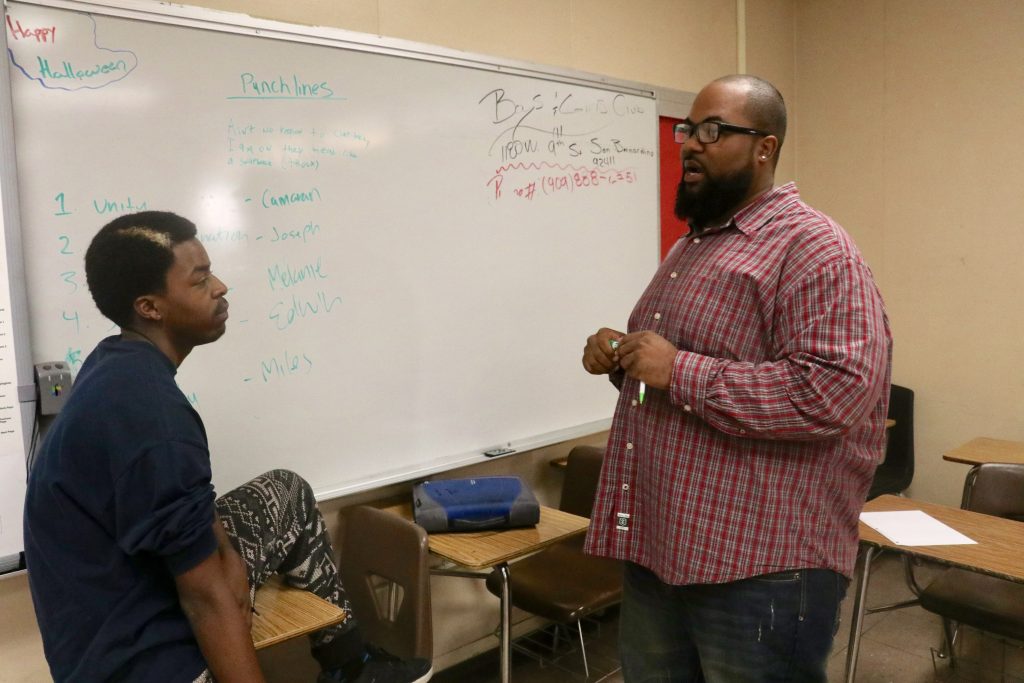
“None of our leaders are following up to see how the families of homicide victims are doing,” Johnson said. “We should mourn all those who lose life in our city because of senseless violence. Hefty (Travon Williams Sr.) was well known in his community, but his life got minimized to just a number because he was nothing to these folks.”
Davis understands the frustration of the community, but believes the city is making progress in addressing the issue of gun violence. The City Council approved an Operation Ceasefire plan of action on October 10 that will create an intervention program in hopes of reducing shootings.
“People would like this fixed now,” Davis said. “And we’re taking steps to ensure that happens. The public doesn’t see it, but these steps will make an impact.”
Father Manny Cardoza of the San Bernardino Diocese, who helps organize the in Inland Congregations United for Change’s Common Ground for Peace Walks, said the city is moving past the terrorist attack.
“It was a tough day, tough week,” he said. “We have to remember these days and continually work for that peace. It’s important we aim to find out what causes folks to do this sort of thing and help them overcome their hatred.”
A powerful image still resonates
A powerful image–displaying a overwhelmed Virginia Marquez hugging Parks and Recreation employee Juanita Webster–was broadcasted across multiple media sites across the world days after December 2.
Marquez, the Councilwoman who represents the city’s First Ward, unknowingly became the face of a city in mourning.
“I didn’t even know that photo was taken until a few days later when it appeared in People Magazine,” said Marquez. “I have no idea who took that picture.”
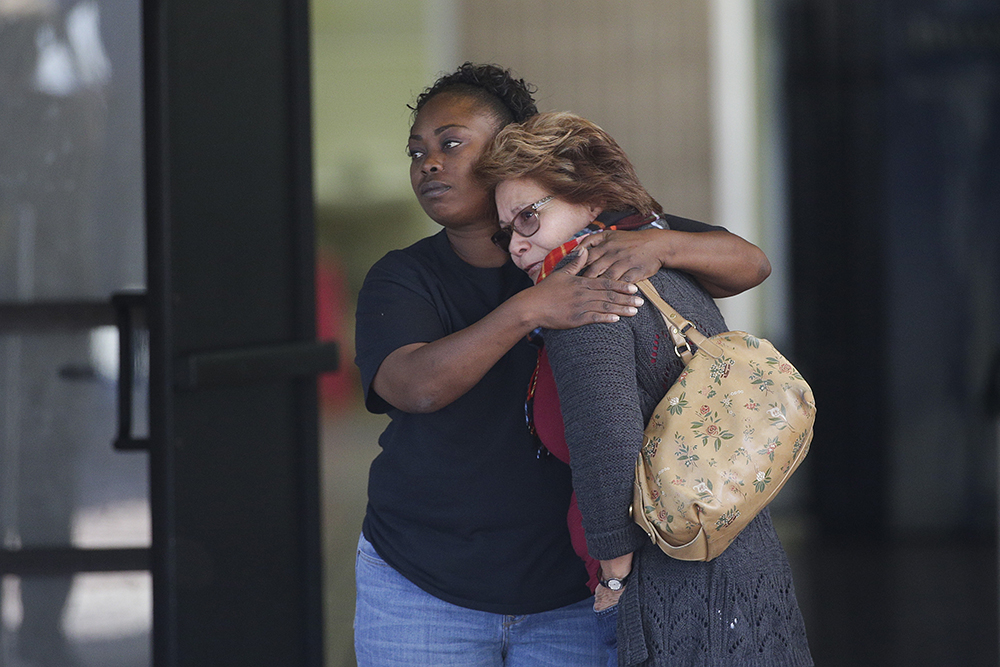
The photo was taken outside the Hernandez Community Center, where Marquez was helping her city colleagues reconnect survivors with their families.
Marquez had just arrived to the location when she confronted Webster at the entrance. “I ran into her arms and said, ‘Juanita, why is God doing this to us?’ She said, ‘No Councilwoman it’s not God, it’s the devil.’ I’ll always remember that picture because of what she shared with me.”
Marquez, who said the day of the attack was the worst day of her life, said a large portion of the community has been traumatized.
“The pain has not subsided,” Marquez said. “We’re still in the grieving process. Everyone is still dealing with it in their own way.”


